
Revisions to TOEFL Writing responses should be made based on priorities. You want to revise the most important aspects of the writing first, and then move on to smaller “proofreading” errors (punctuation, spelling, grammar, etc…) if you have time.
What are the highest priorities (and lowest) when you revise TOEFL Writing?
ETS’s rubrics for TOEFL Writing have the same scoring priorities you’ll find in a regular college writing class. The “broader” aspects of writing– sometimes called higher order concerns (HOCs) are the most importnat and hold the most point weight.
HOCs include the introduction and conclusion, paragraph structure, transitions, arguments, and supporting details.
The official TOEFL Writing score guides put less importance on lower order concerns (LOCs) that don’t directly deal with the deeper structure and meaning of a Writing response. LOCs are things such as spelling, grammar, sentence structure, word choice, and so on.
A TOEFL scorer will only take away points for LOCs if these smaller mistakes are so bad that they “obscure meaning” or make your writing less clear. In other words, lower order concerns aren’t important in TOEFL writing unless they’re serious enough to noticeably impact the HOCs.
Sample TOEFL Writing essay, with errors that need revising
To give you an example of how these HOC/LOC priorities are used in revising an actual TOEFL essay, let’s take a look at the first two paragraphs of an example Integrated Writing. This response contains both high priority and low priority flaws. For now, we’ll focus just on higher order concern revisions, since it’s best to take care of the most important stuff first.
This example will be based on a model Integrated Writing response I showed you in an earlier post. But I’ve added in some errors and mistakes. (The original audio and reading passage for this task is here.)
TOEFL Integrated Writing essay, with mistakes and errors:
- The speakur correct the writing which say comics being as American origin, not world art. Although these writing has all scholars agree that comics are uniquely as unAmerican, the lecturer says that in modern times, nobodie’s agree that. antiquated the popular comic strips were not American. According in first century before the comic strip started USA, there are European comics popularity. The professor says too Hogan’s Alley, of the 1890s comic strip in American in the article, is not completely American because the people who were the auience not the Americans
What a mess! Admittedly, I’ve made a kind of extreme example–you may or may not make this many mistakes in your own practice TOEFL writing. But with all these writing problems, we can look at plenty of ways to improve this essay by applying HOC and LOC priorities.
Making the first TOEFL Writing Revisions
Factual inaccuracy is an especially high priority–if a TOEFL writer misstates the facts from an Integrated Writing prompt, their whole essay is wrong in a way that will really hurt their score. Incorrect facts are incorrect facts, even after they’re revised for clarity.
If you look back at the content of the original prompt, the lecturer doesn’t say that nobody (incorrectly written as “nobodie’s”) agrees with the claim that comics are uniquely American art form. The lecturer simply says that this belief about comics is much less common than it used to be. Additionally, the lecturer actually says that The Yellow Kid is not a fully American comic strip because the characters and author are immigrants who are not originally from the United States. The lecturer does not say that the audience (slightly misspelled as “auience”) of the strip was completely non-American.
TOEFL Writing revisions for factual accuracy (changes in bold):
- The speakur correct the writing which say comics being as American origin, not world art. Although these writing has all scholars agree that comics are uniquely as unAmerican, the lecturer says that in modern times, very few scholars agree that. antiquated the popular comic strips were not American. According in first century before the comic strip started USA, there are European comics popularity. The professor says Hogan’s Alley, of the 1890s comic strip in American in the article, is not completely American because the people who were the creator of the comic and the characters in the comic were immigrants.
Notice that with these HOC corrections, a few errors in lower order concerns are eliminated. The misspelled and mis-punctuated word “nobodie’s” is eliminated, and the phrase ” the auience not the Americans,” which contains mistakes in spelling, punctuation and grammar is also completely removed.
Next, we’ll look at three more higher order concerns that are closely related– introduction, paragraph structure and transitions.
Now, let’s look at a few more revisions we can make, as we continue to focus on priorities for revising
Notice that this with the revisions we’ve made so far, we have a “run-on” paragraph. Even after the revisions for factual inaccuracies, this piece of text is too long. It combines two main ideas into one big, ugly chunk.
The basic disagreement between the passage and lecture is a paragraph-level main idea– an introductory concept that should be in an introductory paragraph. The lecturer’s claim that the earliest newspaper comic strips were not truly American is a separate main idea; it should have its own separate second paragraph. And there should be some transitional language between the two paragraphs.
Correcting other higher order concerns in TOEFL Writing
TOEFL Writing revisions for introduction, paragraph structure, and transitions in bold
The passage states that comics are a uniquely American art form, with clear origins in the United States.
- The speakur correct the writing. Although these writing has all scholars agree that comics are uniquely as unAmerican, the lecturer says that in modern times, very few scholars agree that.
- The speaker further disputes the writer’s claim that antiquated the popular comic strips were not American. According in first century before the comic strip started USA, there are European comics popularity. The professor says too Hogan’s Alley, of the 1890s comic strip in American in the article, is not completely American because the people who were the creator of the comic and the characters in the comic were immigrants.
So a new first sentence has been put in for a stronger introduction. Some of the content was taken from the original first sentence and put into this new initial sentence. In the process, the very ungrammatical phrase “which say comics being as American origin, not world art” is replaced with more proper wording.
Again we see that when you correct the HOCs, some LOCs may take care of themselves– this also happened with some of the HOC revisions earlier in this post.
With the adding of a clear introductory sentence, the ungrammatical phrase “which say comics being as American origin, not world art” has been removed completely. And the oddly-worded sentence fragment “antiquated the popular comic strips were not American” is now part of a complete sentence.
Admittedly, the opening sentence for the second paragraph is still oddly worded, and there are lots of other lower order concerns that haven’t been addressed yet. Some of the uncorrected LOCs have an impact on the HOCs, because errors in grammar, spelling, and so on can make the whole essay harder to understand.
Now that the essay’s organization and strcture are where they truly need to be, we’re ready to take on the lower order concerns (LOCs). LOCs in this case involve editing for grammar, spelling, and other technical aspects of the writing that can make the essay clearer.
The Final Revision: Addressing those Lower Order Concerns (LOCs)
The passage states that comics are a uniquely American art form, with clear origins in the United States.
The speaker disagrees with the passage. Although the passage claims that all scholars agree that comics are a uniquely American type of art, the lecturer says that in modern times, very few scholars actually agree with that.
The speaker further disputes the writer’s claim that the earliest popular comic strips were American. According to the speaker, before the comic books were widely published in the U.S.A., there were popular comic book series in Europe. The professor adds that Hogan’s Alley, the 1890s “American” comic strip mentioned in the passage, is not truly American. The professor points out that the creators involved with the comic and the characters in Hogan’s Alley were immigrants.
As you can see, the lower order concerns, while less urgent during revisions, can still be quite important. This final version of the writing is far easier to read and understand, compared to the version where only the HOCs were addressed.
And for more examples of TOEFL essays that you can revise (and model TOEFL essays you should emulate), see Magoosh’s complete guide to TOEFL Writing samples. After that, you may also want to chekc out Magoosh’s collection of TOEFL Writing topics.






Leave a Reply